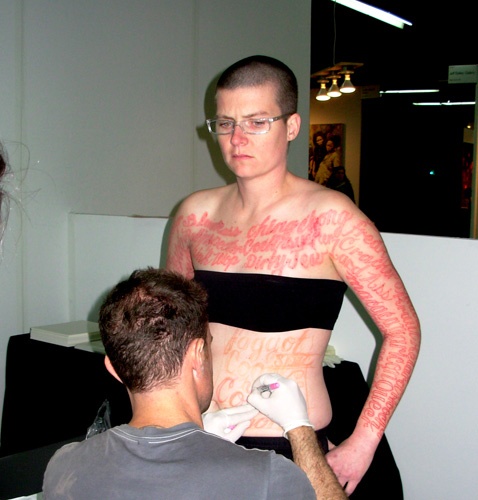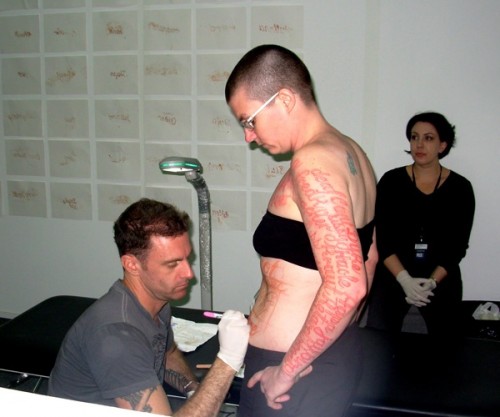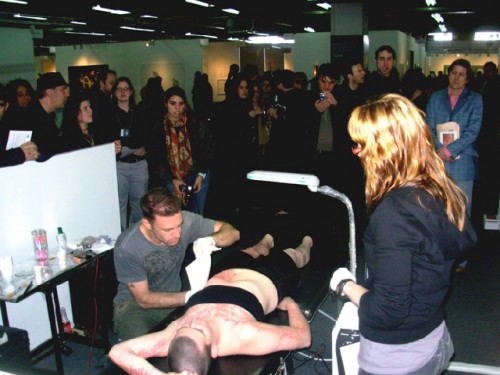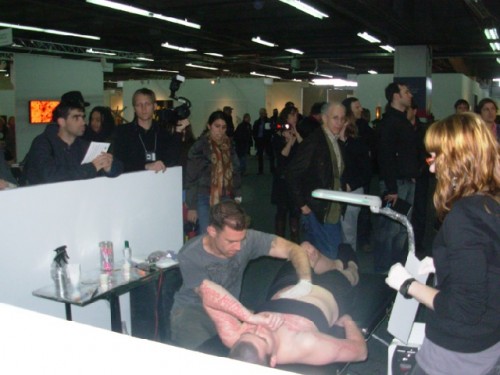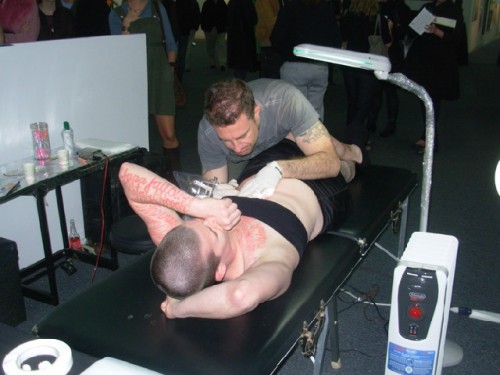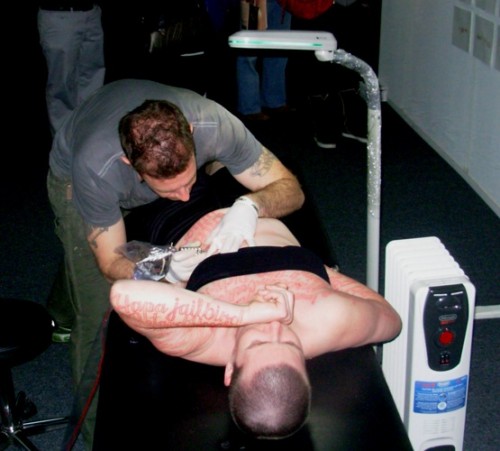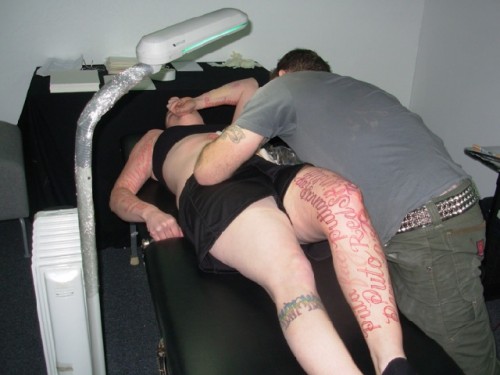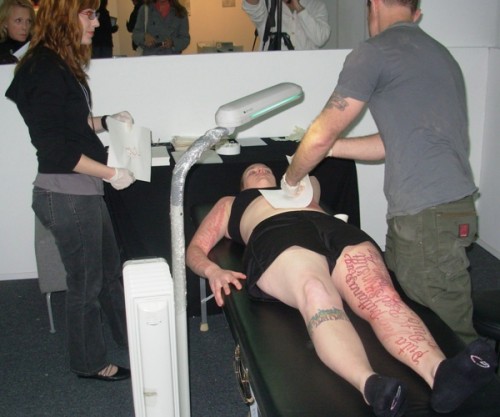Mary Coble Takes the Pulse
Let It Bleed
By: Charles Giuliano - Apr 08, 2008
Mary Coble
Blood Script 2008
Pulse
March 28 and March 29, 1-6 PM
Courtesy of Conner Contemporary Art
http://www.connercontemporary.com/artists/mary-coble
In a conflict of fascination and horror, with a number of other visitors to the Pulse New York art fair, I witnessed a public performance by Mary Coble. Initially, with a throng of others pressing forward to absorb the details of the intense event, a collaborator of the artist, who was wearing gym shorts and a strapless sports bra, inscribed ornately scripted words in red marker all over her skin.
Upon close examination the words represented a lexicon of hate terms. So painful and disturbing that I am not inclined to repeat them. But we have all heard them and arguably even uttered them in moments of fear, anger and violence.
In this work "Blood Script 2008" the artist continues with a mode of performance art that calls our attention to such vile terms by having them tattooed to her skin. But, without the use of ink. What results in these feats of pain and endurance, that last for several hours, are thin lines of blood oozing from the rapid punctures inflicted by the pen like device wielded by a tattoo artist. Once a word has been so inscribed it is then carefully blotted and the small sheets of paper were attached to the nearby wall of the Conner Contemporary Art booth. These are the artifacts of the performance which are undoubtedly then available for sale to collectors. Much in the way that one might have purchased the soiled newspapers anointed by the functions of a coyote in the famous 1974 performance piece by Joseph Beuys "I Like America and America Likes Me."
In earlier works "Marker New York" (2006) "Marker DC" (2007) and "Marker Madrid" Coble stood silently while passersby wrote on her body hate speech which they had experienced. In this recent piece "Blood Script" some 75 of those words were tattooed to her skin. Her artist statement says that "Ornate script creates a dichotomy between the beautiful visual forms of the words and the horrible meanings they convey."
The conundrum of the work is whether is succeeds in evoking in the viewer empathy or sympathy. Do we feel her pain and experience the full impact of the hatred and intolerance they imply? Or, are we merely onlookers and voyeurs perhaps feeling sorry that this young woman is enduring such suffering? Just how is one to respond to this performance?
In an interview with Jessica Dawson in the Washington Post (
The notion of suffering as a martyr to religious belief, social, and political issues is as old as mankind. Consider the 2004 film by Mel Gibson "The Passion of the Christ." It evoked in many an emotional outpouring of intense religious empathy for the graphic suffering of the Christ. Seated in a theater surrounded by many sobbing at the horror I just found the experience revolting to the point of the pornographic. This may indeed be an accurate depiction of the suffering of Jesus but was presented to me through the warped sensibility of an artist whose motives I cannot support or condone. I attended the film, despising every minute of the experience, precisely because I needed to have the experience the better to understand my own critical responses to it.
A similar argument and justification may be applied to the fact that I lingered, documented, and am now writing about Coble's work about which my feeling are unresolved. The fact that she chose to experience this and to create a vehicle for wider understanding through an elective ordeal justifies a critical response to her extreme statement.
Her Tattoo event also evoked memories of reading Franz Kafka's 1919 short story "In the Penal Colony" when I was in college. It was elective reading during a time when I was completely fascinated with Kafka at about the same time I read "The Stranger" by Camus with similar fascination and intensity. Considering those works today they evoke very different responses than when I was an undergraduate. At the time, their extreme positions were more provocative than they are to me now.
A summary of "In the Penal Colony" involved a device for execution in which the sentence of the condemned prisoner's crime in inscribed into his strapped down body until after extreme torture it results in death. Why did I find that notion so intriguing? And just how does that now relate to the similar work of self infliction by Coble? In the Kafka story the prisoner died. But following the performance by Coble, after a day or two of recovery, she no doubt went about her business or is in process of planning her next ordeal. She is apparently admired for doing the good work. With time the inkless tattoos will fade away leaving a tabula rasa for the next statement.
Not to say that Coble is alone in the pursuit of pain and endurance in art. Think of Chris Burden agreeing to be shot, or crucified to a Volkswagen. How about the performances of Hannah Wilkie, Vito Acconci or Rudolph Schwarzkogler, the Vienna Actionist, who is alleged to have sliced off his penis as a performance piece. All of which is really a pain. And art. You have to suffer if you want to sing the blues.



